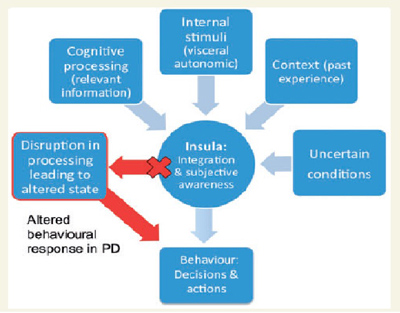
The insula acts as a hub processing external information in the brain and passing it to other networks to take action. When the insula is affected by PD, as seen here, information is accepted but isn't transmitted. (Photo: Dr. Antonio Strafella)
A team of UHN researchers has found a previously overlooked region of the brain may be responsible for some symptoms of Parkinson's disease (PD), an observation that opens a new area for their work.
The findings of the researchers from the Krembil Neuroscience Centre (KNC) and Toronto Western Research Institute (TWRI), was chosen as a "Hot Topic in Neuroscience 2014" at the Society for Neuroscience Conference earlier in November, and published in a study entitled "The contribution of the insula in Parkinson's disease: A quantitative meta-analysis study."
"We are very excited by this discovery and to have this new area of focus for Parkinson's disease research," said Dr. Antonio Strafella, a neurologist, Canada Research Chair in Movement Disorders and Neuroimaging, and the principal investigator of the study.
The insular cortex, known as the insula, is a region of the brain that has many functions. It's believed to be involved in consciousness and reactions based on emotions. It also plays a role in sensory and motor control, self-awareness, behaviour, social interactions and cognitive performance.
More Related to This Story
Think of the insula as the grand central station of any big city. The central station is a connecting point for several different rail networks: inner-city (subway), suburban link (such as Go trains in Toronto), and city-to-city transportation (VIA Rail). Much like the central train station, the insula acts as a connecting hub between different brain networks: processing and passing relevant information along to each area.
"For example, people can describe having a 'gut feeling' about something," Strafella said. "That emotion is based on external information. It's the insula that decodes that information and passes it along to another part of the brain for a particular action based on the received information."
Over the years, Strafella had noticed that along with other areas of the brain, the insula was always activated when scans were taken of brains of patients with PD. The observation spurred him to take a closer look at this brain region and what role it might play in this neurological disease.
With the help of his student Marion Criaud, lead author of the study, Strafella and his team conducted a meta-analysis of over 200 imaging studies for Parkinson's disease – more or less all the scientific literature that existed on the topic.
A meta-analysis is a method of research that contrasts and combines results from different studies in order to identify patterns, differences or interesting similarities among multiple study results. Their analysis technique determined the insula was activated reliably across all studies for PD.
Seeing the insula activated so often led the researchers to hypothesize that this region of the brain might contribute to symptoms associated with the disease. Since the insula is critical to the processing of information, when it is affected by PD, the information may be going into the insula but the signal for a reaction isn't being transmitted to the appropriate brain network. These observations provide important insights in understanding how patients with PD lose the normal function of their bodies.
For instance, many patients with PD have trouble with their memory, they often forget things they did the day before or planned for the same day. The insula plays a role in organization and planning and memory is needed for this capability of the brain to work.
"Although the study's results do not have any immediate implications for treatment of PD," Strafella added, "it will be interesting to see what the long term impact of these findings are as researchers begin to focus on the insula and try to figure out why and how this is happening."
